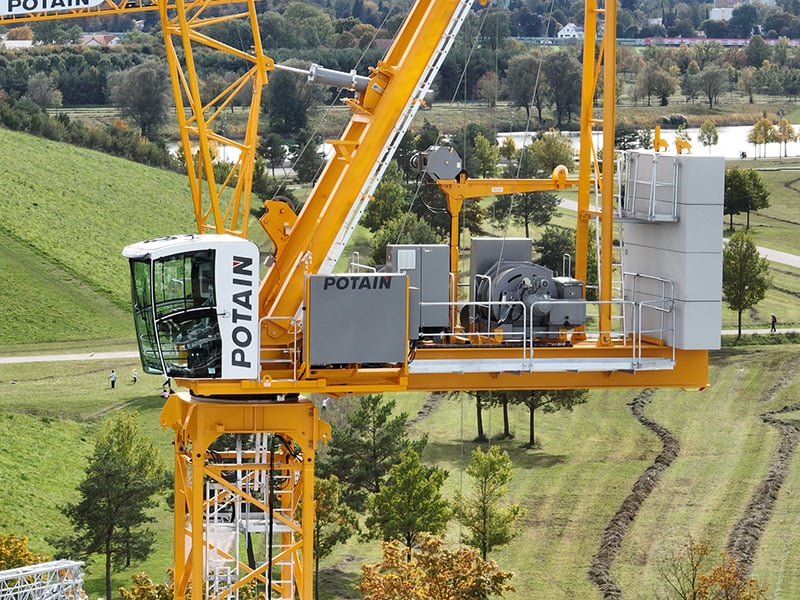Luffing jib cranes are a type of crane that offer flexible lifting solutions for various industries. These cranes are designed to have a luffing jib, which allows for vertical movement of the load, making them ideal for tight spaces or areas with obstacles. With their versatility and adaptability, luffing jib cranes have become an essential tool in construction, shipping, and other industries that require efficient and precise lifting capabilities.
What are Luffing Jib Cranes?
Luffing jib cranes are a type of tower crane commonly used in construction projects. Unlike other types of tower cranes, luffing jib cranes have a jib that can be raised or lowered, allowing for greater flexibility in lifting and positioning loads. This feature is particularly useful in urban areas where space is limited. Luffing jib cranes are known for their ability to work in tight spaces and their ability to lift heavy loads at great heights. They are often used in the construction of high-rise buildings, bridges, and other large-scale infrastructure projects. Luffing jib cranes are operated by skilled crane operators who ensure safe and efficient lifting operations.
Advantages of Luffing Jib Cranes

Luffing jib cranes offer several advantages over other types of cranes. One of the main advantages is their ability to work in confined spaces. The luffing jib allows the crane to operate in areas with limited headroom, making it ideal for urban construction sites or areas with tall buildings. Additionally, luffing jib cranes have a greater lifting capacity compared to other types of cranes. This makes them suitable for heavy lifting tasks, such as moving large construction materials or equipment. Furthermore, the luffing jib can be adjusted to different angles, allowing for precise positioning of loads. Overall, luffing jib cranes provide versatility, efficiency, and safety in various construction projects.
Applications of Luffing Jib Cranes
Luffing jib cranes have a wide range of applications in various industries. One of the main uses of these cranes is in the construction industry, where they are used for lifting and moving heavy materials and equipment on construction sites. The luffing jib allows for precise control and positioning of the load, making it ideal for working in tight spaces or in areas with obstacles. These cranes are also commonly used in ports and shipyards for loading and unloading cargo from ships. Additionally, luffing jib cranes are used in the manufacturing industry for lifting and moving heavy machinery and components. Overall, the versatility and flexibility of luffing jib cranes make them essential equipment in many industries.
Factors to Consider When Choosing a Luffing Jib Crane
When choosing a luffing jib crane, there are several factors that need to be considered. Firstly, the lifting capacity of the crane is crucial. It is important to determine the maximum weight that the crane will need to lift in order to ensure that it is capable of handling the required loads. Additionally, the height and reach of the crane should be taken into account. The crane should be able to reach the desired height and have sufficient reach to cover the required area. Another important factor is the speed and control of the crane. It should have smooth and precise movements to ensure safe and efficient operation. Finally, the cost and maintenance requirements of the crane should also be considered to ensure that it is a cost-effective and sustainable choice.
Maintenance and Safety Tips for Luffing Jib Cranes
Luffing jib cranes are essential equipment in construction and industrial settings. To ensure their optimal performance and safety, regular maintenance is crucial. Firstly, inspect the crane’s components, such as the wire ropes, sheaves, and hooks, for any signs of wear or damage. Lubricate the moving parts to prevent friction and ensure smooth operation. Additionally, check the electrical system for any loose connections or faulty wiring. Regularly test the crane’s safety features, including the limit switches and emergency stop buttons, to ensure they are functioning correctly. Lastly, provide proper training to operators on safe operating procedures and conduct regular safety audits to identify and address any potential hazards.
Future Trends in Luffing Jib Crane Technology
Luffing jib crane technology is constantly evolving to meet the demands of the construction industry. One future trend in this technology is the development of more advanced control systems. These systems will allow for more precise and efficient operation of the crane, reducing the risk of accidents and improving productivity. Another trend is the use of lighter and stronger materials in the construction of luffing jib cranes. This will enable cranes to have a higher lifting capacity while also being more compact and easier to transport. Additionally, there is a growing focus on incorporating automation and remote control capabilities into luffing jib cranes, allowing for safer and more efficient operation.
Conclusion
In conclusion, luffing jib cranes offer a flexible and efficient solution for lifting heavy loads in various construction and industrial settings. Their ability to adjust the angle of the jib allows for precise positioning and maneuverability, making them ideal for tight spaces and complex projects. With their advanced technology and safety features, luffing jib cranes are a reliable and cost-effective choice for any lifting needs.
What is a luffing jib crane?
A luffing jib crane is a type of crane that features a jib arm that can be raised or lowered to adjust the height of the load being lifted. This flexibility allows for efficient lifting in tight spaces or areas with obstacles.
What are the advantages of using a luffing jib crane?
Some advantages of using a luffing jib crane include its ability to work in confined spaces, its flexibility in adjusting the height of the load, and its ability to reach over obstacles. It is also known for its high lifting capacity and precise control.
What industries commonly use luffing jib cranes?
Luffing jib cranes are commonly used in industries such as construction, shipbuilding, power plants, and oil and gas. They are particularly useful in urban areas where space is limited and in projects that require lifting heavy loads at various heights.
What safety measures should be taken when operating a luffing jib crane?
When operating a luffing jib crane, it is important to follow safety guidelines such as ensuring proper training for operators, conducting regular inspections and maintenance, using appropriate rigging equipment, and adhering to load capacity limits. It is also crucial to have a clear communication system in place between the crane operator and the ground crew.
Can a luffing jib crane be customized to specific project requirements?
Yes, luffing jib cranes can be customized to meet specific project requirements. They can be designed with different lifting capacities, jib lengths, and height adjustments. Additionally, various attachments and accessories can be added to enhance their functionality and adaptability.
How can I choose the right luffing jib crane for my project?
Choosing the right luffing jib crane for your project involves considering factors such as the required lifting capacity, the available space for operation, the height and reach needed, and any specific project requirements. It is recommended to consult with crane experts or manufacturers who can provide guidance based on your project’s needs.

